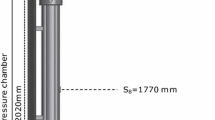Abstract
The present article aims to perform numerical calculations for inter-spray impingement of two diesel sprays under a high injection pressure and to propose a new hybrid model for droplet collision on the basis of literature findings. The hybrid model is compared with the original 0’ Rourke’s model, which has been widely used for spray calculations. The main difference between the hybrid model and the O’Rourke’s model is mainly in determination of the collision threshold condition, in which the preferred directional effect of droplets and a critical collision radius are included. The Wave model involving the cavitation effect inside a nozzle is used for predictions of atomization processes. Numerical results are reported for different impingement angles of 60° and 90° in order to show the influence of the impinging angle on spray characteristics and also compared with experimental data. It is found that the hybrid model shows slightly better agreement with experimental data than the O’Rourke’s model.
Similar content being viewed by others
Abbreviations
- E boun :
-
Probability of bouncing collision Probability of coalescence collision
- E coal :
-
Droplet diameter
- D :
-
Distance between two parcels
- D 1,2 :
-
Spray tip penetration length
- L tip :
-
Number of collisions per time step
- N :
-
Cumulative number of bouncing collisions during a total time duration
- N c,boun :
-
Cumulative number of coalescence collisions during a total time duration
- N c, coat :
-
Cumulative number of coalescence collisions during a total time duration
- N c, sep :
-
Cumulative number of separation collisions during a total time duration
- N c :
-
Cumulative number of collisions (=N c,boun +N c,coal +N c,sep ) during a total time duration
- n :
-
Number of drops in a parcel
- P o :
-
Probability of no collision
- P n :
-
Poisson distribution
- r :
-
Radius of drops
- R c :
-
Ratio of a total number of cumulative collisions to a total number of injected parcels
- R crit :
-
Critical radius of collision
- S z :
-
Distance from the nozzle tip to the impingement point
- t :
-
Time
- U :
-
Velocity of drops
- W e :
-
Weber number
- X :
-
Location of droplet parcel
- XX :
-
Random number
- Z t :
-
Distance from the impingement point to the spray tip
- γ:
-
Ratio of collector drop diameter to colliding drop diameter to colliding drop diameter
- ν:
-
Collision frequency
- ∀:
-
Volume of computational cell
- 1:
-
Collector drop
- 2:
-
Colliding drop
- bound:
-
Grazing bounce regime
- coal:
-
Coalescence regime
- sep:
-
Separation regime
References
Allocca, L., Belardini, P., Bertoli, C., Corcione, F. E. and De Angelis, F., 1992,Experimental and numerical analysis of a diesel spray, Society of Automotive Engineers Paper 920576.
Arai, M. and Saito, M., 1999,Atomization Characteristics of Jet-to-Jet and Spray-to-Spray Impingement Systems, Atomization and Sprays, Vol. 9, pp. 399–417.
Bai, C., 1996,Modeling of Spray Impingement Processes, Ph. D. Thesis, Imperial College of Science and Technology and Medicine, Department of Mechanical Engineering, University of London.
Brazier-Smith, P. R., Jennigs, S. G. and Latham, J., 1972,The Interaction of Falling Water Drops: Coalescence, Proceedings of Royal Society of London A, Vol. 326, pp. 393–408.
Brenn, G., Kalenderski, St. and Ivanov, I., 1997,Investigation of the Stochastic Collisions of Drops Produced by Rayleigh Breakup of Two Laminar Liquid Jets, Physics of Fluids, Vol. 9, pp. 349–364.
Chiba, T., Saito, M., Amagai, K. and Arai, M., 2000,Inter-Spray Impingement of Two Diesel Sprays, ICLASS2000, CA, USA, July.
Gavaises, M., 1997,Modeling of Diesel Fuel Injection Processes, Ph. D. Thesis, Imperial College of Science and Technology and Medicine, Department of Mechanical Engineering, University of London.
Gosman, A. D. and Ioannides, E., 1983,Aspects of Computer Simulation of Liquid-Fuelled Combustors, Energy, Vol. 7, No. 6, pp. 482–490.
Lee, S. H. and Ryou, H. S., 2000,Comparison of Spray/Wall Impingement Models with Experimental Data, J. of Propulsion and Power, Vol. 16, No. 6, pp. 939–945.
Nordin, N., 2000,Complex Chemistry Modeling of Diesel Spray Combustion, Ph. D. Thesis, Chalmers University of Technology, Sweden.
O’Rourke, P. J., 1981,Collective Drop Effects on Vaporizing Liquid Sprays, Ph. D. Thesis, Mechanical and Aerospace Engineering, Princeton University, USA.
Orme, M., 1997,Experiments on Droplet Collisions, Bounce, Coalescence and Dispersion, Prog. Energy Combustion Sci., Vol. 23, pp. 65–79
Reitz, R. D. and Diwakar, R., 1986,Effect of Drop Breakup on Fuel Sprays, Society of Automotive Engineers Paper 860469.
Reitz, R. D. 1987,Modelling Atomization Process in High Pressure Vaporizing Sprays, Atomization and Spray Technology, pp. 309–337,
Reynolds, W. C., 1980,Modeling of Fluid Motions in Engines and Introductory Overview, in Combustion Modeling in Reciprocating Engines, Ed. J. N. Mattavi and C. A. Amann Plenum Press, NY.
Sarre, C. K., Kong, S. -C. and Reitz, R. D., 1999,Modeling the Effects of Injector Nozzle Geometry on Diesel Sprays, Society of Automotive Engineers Paper 1999-01-0912.
Yurteri, C. U., Kadambi, J. R. and Arik, E., 1993,Spray Characterization and Droplet Interactions Study Using Particle Dynamic Analyzer, Proceedings of 5th mt. Conf. On Laser Anemomety, Advances and Applications, pp. 145–152.
Author information
Authors and Affiliations
Corresponding author
Rights and permissions
About this article
Cite this article
Lee, S.H., Ko, G.H. & Ryou, H.S. A numerical study on the spray-to-spray impingement system. KSME International Journal 16, 235–245 (2002). https://doi.org/10.1007/BF03185175
Received:
Revised:
Issue Date:
DOI: https://doi.org/10.1007/BF03185175




